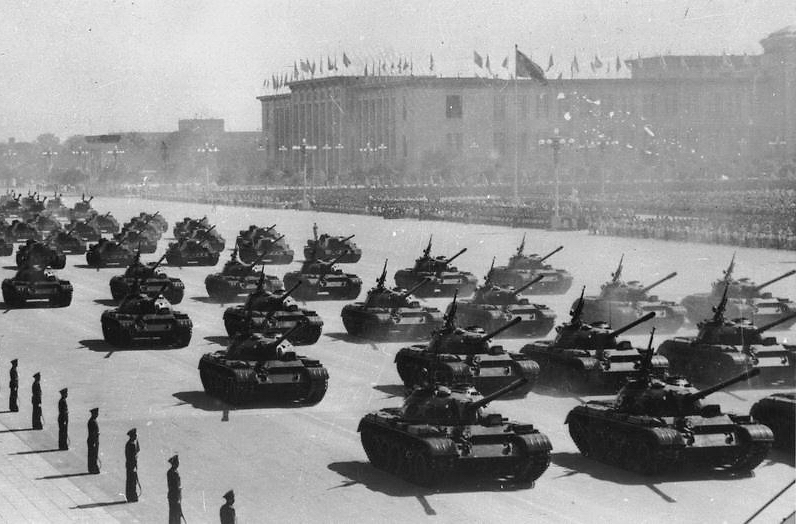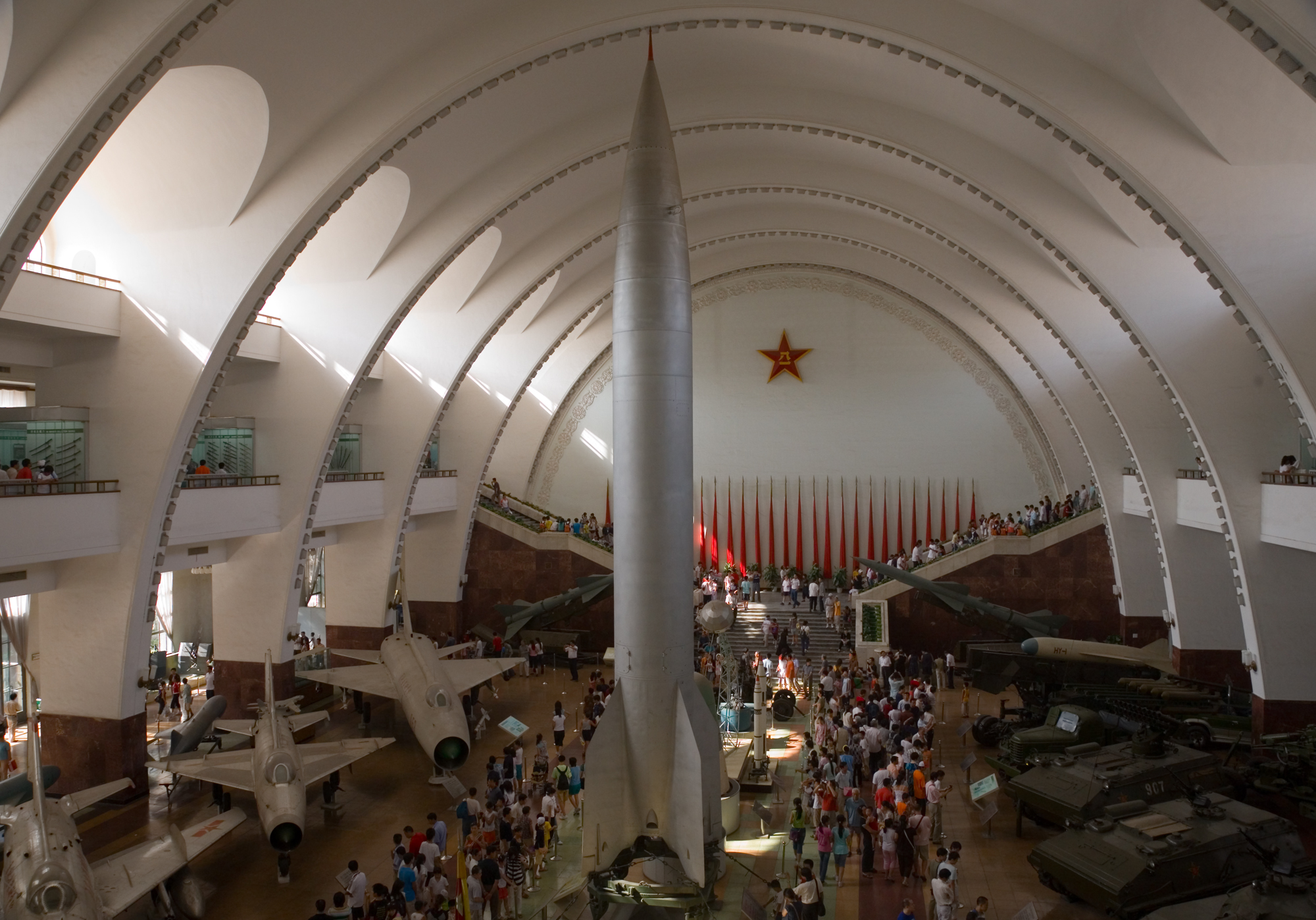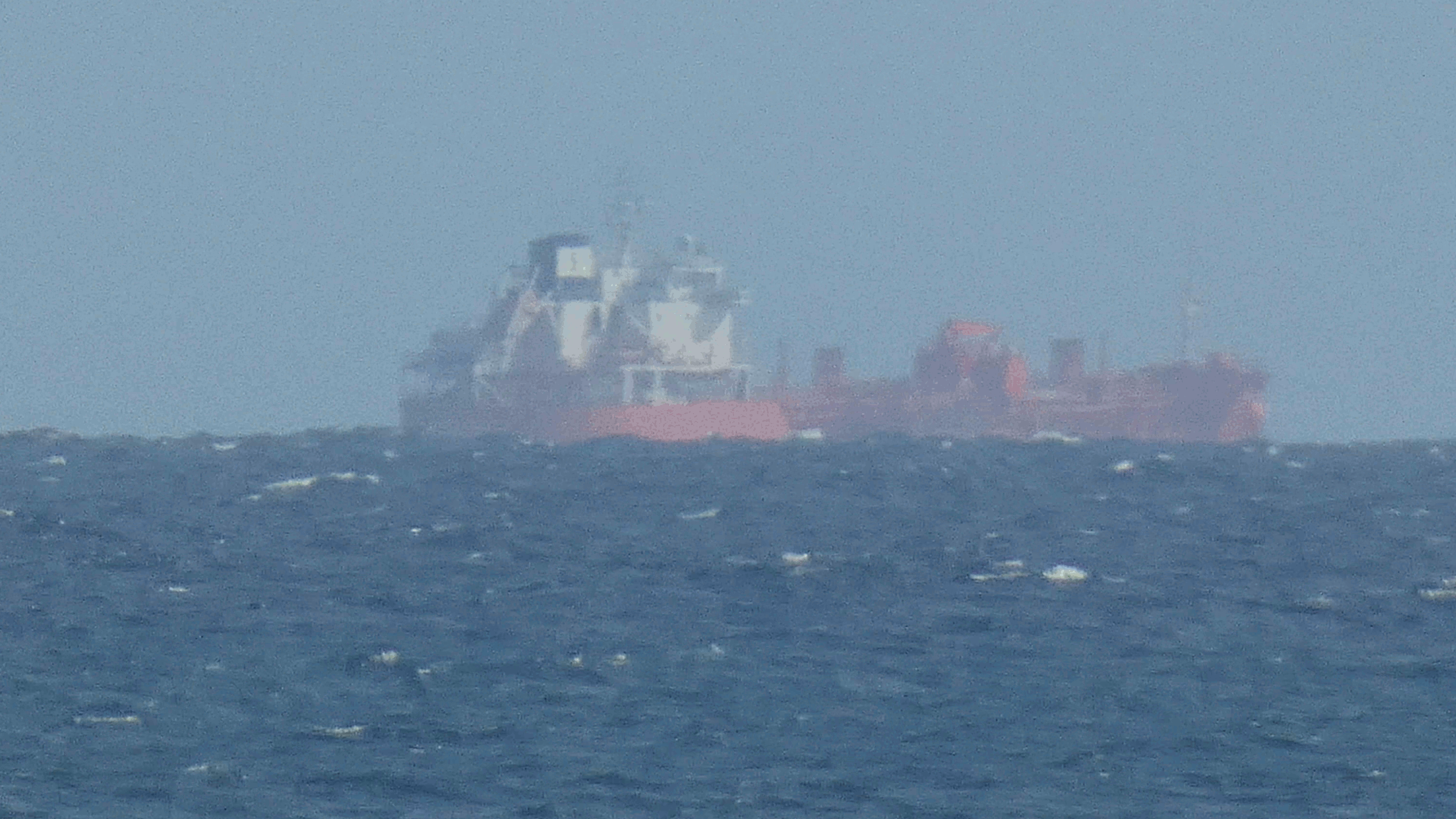|
Type 59 Tank
The Type 59 (; industrial designation: WZ-120) main battle tank is a Chinese-produced version of the Soviet T-54A tank, an early model of the ubiquitous T-54/55 series. The first vehicles were produced in 1958 and it was accepted into service in 1959, with serial production beginning in 1963. Over 10,000 of the tanks were produced by the time production ended in 1985 with approximately 5,500 serving with the Chinese armed forces. The tank formed the backbone of the Chinese People's Liberation Army armoured units until the early 2000s, with an estimated 5,000 of the later Type 59-I and Type 59-II variants in service in 2002. The Type 59 was modified several times during its service. It was also the basis of several later Chinese tank designs including the Type 69 and Type 79 tanks. Description The Type 59 is almost identical to the early production Soviet T-54As, but there are some key differences. The Type 59 was not originally fitted with the infrared searchlight or main gu ... [...More Info...] [...Related Items...] OR: [Wikipedia] [Google] [Baidu] |
Military Museum Of The Chinese People's Revolution
The Military Museum of the Chinese People's Revolution or China People's Revolution Military Museum () is a museum located in Haidian District, Beijing, China that displays restored military equipment from the history of the People's Liberation Army, up to and including modern-day machinery. One of the Ten Great Buildings erected in celebration of the ten-year anniversary of the founding of the People's Republic of China, construction of the museum began in October 1958 and ended in 1960. Collections The museum's four floors include ten halls, the largest of which is the Hall of Weapons. The Hall's extensive holdings of antiquated weaponry showcase domestic and foreign weapons, including blades, small arms, artillery, tanks, armored personnel carriers, anti-air weaponry, jet fighters, rockets and rocket launchers, and cruise missiles. Foreign weapons include Soviet Union, Soviet tanks purchased or donated during the 1950s and 1960s, Japanese weaponry captured during the Second ... [...More Info...] [...Related Items...] OR: [Wikipedia] [Google] [Baidu] |
Soviet Union
The Soviet Union,. officially the Union of Soviet Socialist Republics. (USSR),. was a transcontinental country that spanned much of Eurasia from 1922 to 1991. A flagship communist state, it was nominally a federal union of fifteen national republics; in practice, both its government and its economy were highly centralized until its final years. It was a one-party state governed by the Communist Party of the Soviet Union, with the city of Moscow serving as its capital as well as that of its largest and most populous republic: the Russian SFSR. Other major cities included Leningrad (Russian SFSR), Kiev (Ukrainian SSR), Minsk ( Byelorussian SSR), Tashkent (Uzbek SSR), Alma-Ata (Kazakh SSR), and Novosibirsk (Russian SFSR). It was the largest country in the world, covering over and spanning eleven time zones. The country's roots lay in the October Revolution of 1917, when the Bolsheviks, under the leadership of Vladimir Lenin, overthrew the Russian Provisional Government ... [...More Info...] [...Related Items...] OR: [Wikipedia] [Google] [Baidu] |
Sino-Soviet Treaty Of Friendship
The Sino-Soviet Treaty of Friendship, Alliance and Mutual Assistance (Russian: Советско-китайский договор о дружбе, союзе и взаимной помощи, ), or Sino-Soviet Treaty of Friendship and Alliance for short, was a bilateral treaty of alliance, collective security, aid and cooperation concluded between the People's Republic of China and the Union of Soviet Socialist Republics on February 14, 1950. It superseded the previous Sino-Soviet treaty signed by the Kuomintang government. This treaty was signed against the background of the establishment of China's communist regime and the Cold War confrontation, resulting directly from Mao's foreign policy directive of " leaning to one side" (siding with the socialist camp) and Stalin's strategic and ideological considerations pertaining to the extension of Soviet influence in East Asia. Chairman of the Chinese Communist Party Mao Zedong travelled to the Soviet Union to sign the treaty, one of ... [...More Info...] [...Related Items...] OR: [Wikipedia] [Google] [Baidu] |
Vehicle Suspension
Suspension is the system of tires, tire air, springs, shock absorbers and linkages that connects a vehicle to its wheels and allows relative motion between the two. Suspension systems must support both road holding/ handling and ride quality, which are at odds with each other. The tuning of suspensions involves finding the right compromise. It is important for the suspension to keep the road wheel in contact with the road surface as much as possible, because all the road or ground forces acting on the vehicle do so through the contact patches of the tires. The suspension also protects the vehicle itself and any cargo or luggage from damage and wear. The design of front and rear suspension of a car may be different. History An early form of suspension on ox-drawn carts had the platform swing on iron chains attached to the wheeled frame of the carriage. This system remained the basis for most suspension systems until the turn of the 19th century, although the iron ch ... [...More Info...] [...Related Items...] OR: [Wikipedia] [Google] [Baidu] |
Diesel Engine
The diesel engine, named after Rudolf Diesel, is an internal combustion engine in which ignition of the fuel is caused by the elevated temperature of the air in the cylinder due to mechanical compression; thus, the diesel engine is a so-called compression-ignition engine (CI engine). This contrasts with engines using spark plug-ignition of the air-fuel mixture, such as a petrol engine (gasoline engine) or a gas engine (using a gaseous fuel like natural gas or liquefied petroleum gas). Diesel engines work by compressing only air, or air plus residual combustion gases from the exhaust (known as exhaust gas recirculation (EGR)). Air is inducted into the chamber during the intake stroke, and compressed during the compression stroke. This increases the air temperature inside the cylinder to such a high degree that atomised diesel fuel injected into the combustion chamber ignites. With the fuel being injected into the air just before combustion, the dispersion of the fuel is une ... [...More Info...] [...Related Items...] OR: [Wikipedia] [Google] [Baidu] |
Hull-down
In sailing and warfare, hull-down means that the upper part of a vessel or vehicle is visible, but the main, lower body ( hull) is not; the term hull-up means that all of the body is visible. The terms originated with sailing and naval warfare in which the curvature of the earth causes an approaching vessel to be first visible "sails-up". Beginning in the 20th century, ''hull-down'' has also been used in armoured warfare. In modern armoured warfare, hull-down is a position taken up by an armoured fighting vehicle (AFV) so that its hull (the main part of the vehicle) is behind a crest or other raised ground, but its turret (or a superstructure or roof-mounted weapon) is exposed. Turret-down is the position in which the vehicle's crew can observe forward from roof hatches, but the vehicle is completely hidden (usually a few metres further back from a hull-down position). The belly armour should not be exposed, because it is vulnerable to even modest antitank weapons. Ships When ... [...More Info...] [...Related Items...] OR: [Wikipedia] [Google] [Baidu] |
Type 59 In Parde
Type may refer to: Science and technology Computing * Typing, producing text via a keyboard, typewriter, etc. * Data type, collection of values used for computations. * File type * TYPE (DOS command), a command to display contents of a file. * Type (Unix), a command in POSIX shells that gives information about commands. * Type safety, the extent to which a programming language discourages or prevents type errors. * Type system, defines a programming language's response to data types. Mathematics * Type (model theory) * Type theory, basis for the study of type systems * Arity or type, the number of operands a function takes * Type, any proposition or set in the intuitionistic type theory * Type, of an entire function ** Exponential type Biology * Type (biology), which fixes a scientific name to a taxon * Dog type, categorization by use or function of domestic dogs Lettering * Type is a design concept for lettering used in typography which helped bring about modern textual printin ... [...More Info...] [...Related Items...] OR: [Wikipedia] [Google] [Baidu] |
Glacis
A glacis (; ) in military engineering is an artificial slope as part of a medieval castle or in bastion fort, early modern fortresses. They may be constructed of earth as a temporary structure or of stone in more permanent structure. More generally, a glacis is any slope, natural or artificial, which fulfils the above requirements. The etymology of this French word suggests a slope made dangerous with ice, hence the relationship with ''glacier''. A ''glacis plate'' is the sloped armour, sloped front-most section of the hull of a tank or other armoured fighting vehicle. Ancient fortifications A glacis could also appear in ancient fortresses, such as the one the ancient Egyptians built at Semna (Nubia), Semna in Nubia. Here it was used by them to prevent enemy siege engines from weakening defensive walls. Hillforts in Britain started to incorporate glacis around 350 BC. Those at Maiden Castle, Dorset, Maiden Castle, Dorset were high. Medieval fortifications Glacis, also call ... [...More Info...] [...Related Items...] OR: [Wikipedia] [Google] [Baidu] |
DShK
The DShK 1938 (Cyrillic: ДШК, for russian: Дегтярёва-Шпагина Крупнокалиберный, Degtyaryova-Shpagina Krupnokaliberny, links=no, "Degtyaryov-Shpagin large-calibre") is a Soviet heavy machine gun with a V-shaped butterfly trigger, firing the 12.7×108mm cartridge. The weapon was also used as a heavy infantry machine gun, where it was frequently deployed with a two-wheeled mounting and a single-sheet armour-plate shield. The DShK's name is derived from its original designer, Vasily Degtyaryov, and Georgi Shpagin, who later improved the cartridge feed mechanism. It is sometimes nicknamed Dushka (a dear or beloved person) in Russian-speaking countries, from the abbreviation. Alongside the American M2 Browning, the DShK is the only .50 caliber machine gun designed prior to World War II that remains in service to the present day. History Requiring a heavy machine gun similar to the M2 Browning, development of the DShK began in the Soviet Union in 1929 an ... [...More Info...] [...Related Items...] OR: [Wikipedia] [Google] [Baidu] |
Periscope
A periscope is an instrument for observation over, around or through an object, obstacle or condition that prevents direct line-of-sight observation from an observer's current position. In its simplest form, it consists of an outer case with mirrors at each end set parallel to each other at a 45° angle. This form of periscope, with the addition of two simple lenses, served for observation purposes in the trenches during World War I. Military personnel also use periscopes in some gun turrets and in armoured vehicles. More complex periscopes using prisms or advanced fiber optics instead of mirrors and providing magnification operate on submarines and in various fields of science. The overall design of the classical submarine periscope is very simple: two telescopes pointed into each other. If the two telescopes have different individual magnification, the difference between them causes an overall magnification or reduction. Early examples Johannes Hevelius described an early ... [...More Info...] [...Related Items...] OR: [Wikipedia] [Google] [Baidu] |
Gun Stabilizer
A gun stabilizer is a device that facilitates aiming an artillery piece by compensating for the motion of the platform on which it is mounted. For naval applications see ship gun fire-control system. Moving land-based systems tend to require more specialized stabilization. Due to the need to fire while in motion, tanks in World War II made some use of stabilization, but it became commonplace in later decades such as the cold war period. History The gunner of the early Matilda II tank elevated and depressed the gun by hand, and had a shoulder pad by which he could support it steadily as the tank moved while he stood. The primary armament of most US tanks was stabilized in elevation starting with the M3A1 Light Tank and the M3 Medium tank in November 1941. Except for the 105mm-equipped M4 Sherman tanks, all U.S.-built tanks had a stabilization system for gun elevation usable at low speeds.Page 60, SHERMAN: A History of the American Medium Tank, 1978. R.P. Hunnicutt, All US tanks ... [...More Info...] [...Related Items...] OR: [Wikipedia] [Google] [Baidu] |
Type 69 Tank
The Type 69 () and Type 79 () are Chinese second generation main battle tanks. Both were developments of the Type 59 medium tank (a locally produced Soviet T-54A) with technologies derived from T-62. They were the first indigenously developed main battle tanks by China, although also classified as medium tanks while in development and service. Their lineage from the T-54A can be seen through the distinct gap between the first and second road wheels. Other improvements included a new engine, ballistic computers, and laser rangefinders. The more advanced Type 79 variant was equipped with a 105 mm rifled gun which was also found on the Type 80 tank. History Development of the Type 69 After the Sino-Soviet split, the Soviet Union withdrew its technical staff and support to China's arms industry. This caused China's domestic tank development to stagnate significantly. Sometime after 1960, the PLA tank corps and Fifth Ministry of Machine Building embarked on the development o ... [...More Info...] [...Related Items...] OR: [Wikipedia] [Google] [Baidu] |



.png)




